|
Battle of Fort Anderson
North Carolina Coast and Civil War
Introduction
Fort Anderson was an earthen fort located in the lower Cape Fear Region
of North Carolina. Constructed at Brunswick Town, in Brunswick County, Fort Anderson was a crude dirt and sand fortress
used by the Confederates during the American Civil War (1861-1865). As part of the Cape Fear Defense System, Fort Anderson
was one of many forts located along the waterways and designed to defend the Cape Fear River inlets and
Wilmington upriver. Earthen batteries of the fort were used as platforms and shields for the Confederate cannons. Beneath
some of its earthworks were "bombproofs," shelters used by troops during enemy bombardment. The Confederacy decided to build
forts on the Cape Fear River to protect the port of Wilmington from the Union blockade. During the Civil War, blockade runners
brought supplies such as iron, guns, and ammunition to the Confederacy. The primary purpose of Fort Anderson was to protect
the port city of Wilmington by hindering the movement of Union ships, and to serve as a debarkation point for blockade
runners fortunate enough to make it up the mouth of the Cape Fear River. Fort Anderson was built on the ruins of Brunswick
Town and was originally named Fort St. Philip, after the ruins of the Revolutionary period church nearby. The name was soon
changed to honor Col. George B. Anderson.
In January and February 1865, when the Federals captured Fort Fisher
and Wilmington to cut the Confederate supply line to Virginia,
Confederate forces under Gen. Johnson Hagood retreated to Fort Anderson from Fort
Fisher. The Federals soon followed and found Gen. Robert F. Hoke’s
Confederates entrenched from the fort west to Orton Pond. For three days, Union Gen. Jacob D. Cox demonstrated in front of
the fort and Gen. Hoke’s troops, had gunboats in the river shell the fort, and marched a flanking force around Orton
Pond to attack the fort’s unprotected rear. During the early morning of February 19, as the attack began, Hagood evacuated
Fort Anderson,
and the Federals immediately occupied it.
| Fort Anderson Historical Marker |
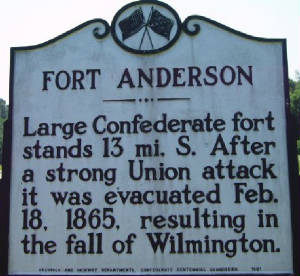
|
| Civil War Battle of Fort Anderson, North Carolina |
Background
By 1864, only the Confederate capital of Richmond was more important to the fledgling nation than the port
of Wilmington, N.C. The Cape Fear River was vital to blockade running ships, bringing vital supplies into the interior of
the Confederacy, trade, and access to railroad lines to the various fronts throughout the South.
There were two paths to gain access to the Cape Fear and Wilmington: Old
Inlet, to the south and west of Bald Head Island, and New Inlet, formed during a major hurricane in 1769, to the north of
Bald Head Island. Forts Caswell, Campbell, and Battery Shaw on Oak Island, along with Fort Holmes on Bald Head Island guarded
the Old Inlet entrance to Cape Fear. Fort Fisher was built on Federal Point to guard the New Inlet, and it was considered
impregnable by both the Union and the Confederacy. Interior river fortifications leading up to Wilmington included Fort Johnston
(renamed Fort Pender in 1864), a number of earthen batteries, and Fort Anderson.
In 1862, it was decided that another fort would be built on the location
of the old colonial Brunswick Town to aid in the defense of the precious port, Wilmington. “Brunswick struck [Brig.
Gen. Samuel Gibbs] French as an ideal site to build a fortification. Although the Cape Fear River was more than a mile wide
at that point, low bluffs overlooked the river’s narrow channel, which ran within a few yards of the west bank. A battery
on high ground, French believed, would command both the river traffic and the western land approaches to Wilmington.”
Maj. Thomas Rowland was charged with construction of the fort, which he
called Fort St. Philips, after the ruins of St. Philips Church, which sat within the fortification's walls. Rowland took up
residence at nearby Orton Plantation, while he supervised the construction of Fort St. Philips. The
fortifications consisted of two earthenwork batteries. Battery A ran parallel to the Cape Fear. Wooden barracks were built
in a safe area behind the battery. Battery B ran perpendicular to the Cape Fear, extending from the river to the walls of
St. Philips Church. “High buffer mounds were erected behind this battery which was equipped with 32 pound guns. A breech
loading weapon with a long-range firing capacity was also used. This was the Whitworth gun, several of which were brought
from other forts in the area. Other guns in the fort were three rifled 32 pounders, six smoothbore 32 pounders, and three
smoothbore 24 pounders.” The fortifications extended westward beyond smaller ponds, until they reached the larger Orton
Pond. The fort was subsequently improved and enlarged while under the commands of Maj. William Lamb and Maj. John J. Hedrick.
On July 1, 1863, the name was changed to Fort Anderson to honor Brig. Gen. George Burgwyn Anderson, who had been mortally
wounded at Antietam.
| Fort Anderson Civil War Map |
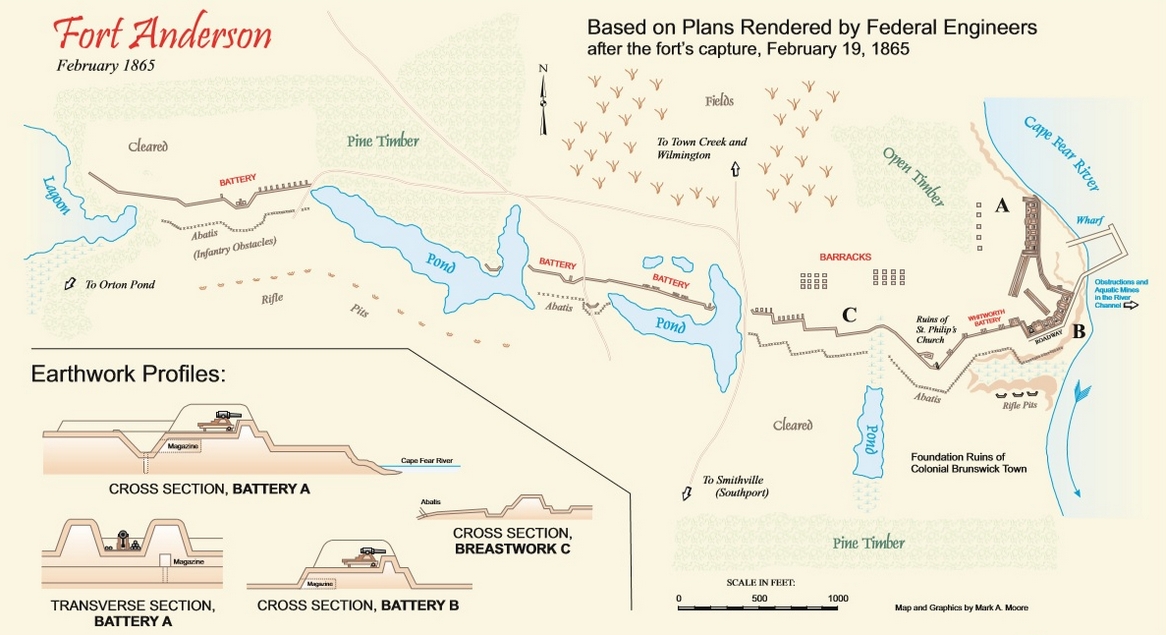
|
| Battle of Fort Anderson |
Summary
Located in North Carolina, Confederate Fort Anderson was a large earthen fort that guarded the port of Wilmington, on the western bank of the Cape Fear River Defense System. After the fall of nearby Fort Fisher in January of 1865, Fort Anderson
was bombarded and seized by Union troops during their march to capture Wilmington.
Its beautifully preserved coastal defenses were built atop the ruins of colonial Brunswick
town. During the Civil War, there was also Union Fort Anderson, aka Deep Gully, on the north bank of the Neuse River
directly opposite New Bern. The Union fort, located in Craven
County, was flanked on both sides by swamps and was approachable only in front along a narrow causeway.
The
battle of Fort Anderson did not begin
until after Fort Fisher
fell. On January 22, 1865, seven one-hundred pound Parrot shells were shot at the fort and made contact with a warehouse.
The US Navy shot at the fort on the February 10th. After a couple of days, nothing happened. Then on February 17th, the shooting
recommenced and the fort attempted to fight back with only mediocre supplies. The fighting continued for three days.
The people of Fort Anderson
were forced to evacuate quickly due to the enemy's overwhelming numbers. Next, the US Army approached the empty fort.
The US Navy began an attack on the army, thinking that it was the Confederate army. Of course, however, the US Army surrendered
quickly by raising a white flag. It is the only time in history where the US Army surrendered to the US Navy.
| Battle of Fort Anderson |
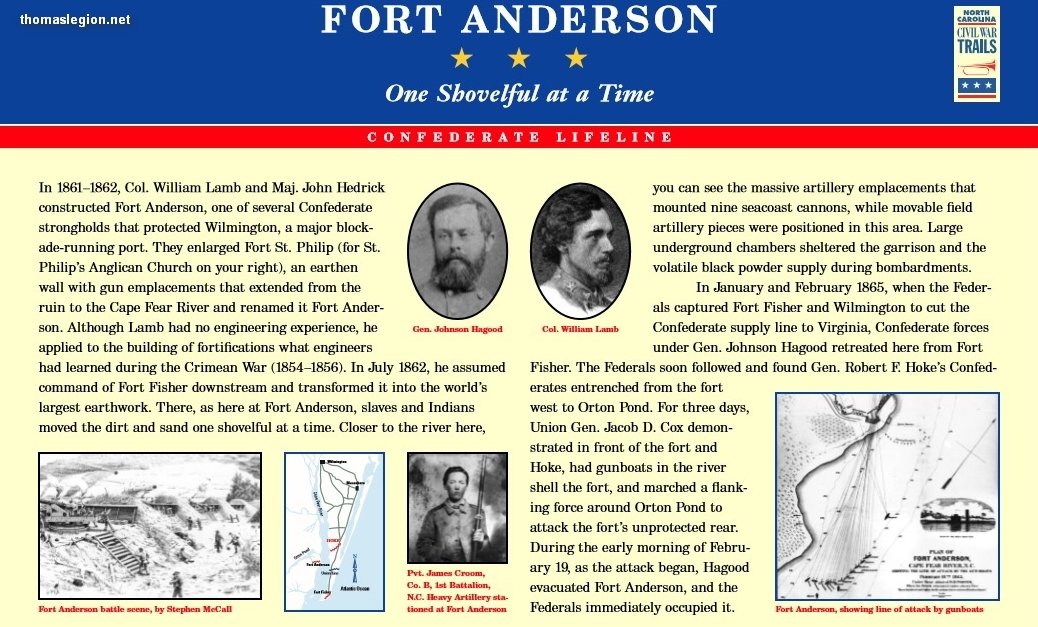
|
| Fort Anderson Civil War History |
After a strong Union attack it was evacuated Feb. 18, 1865, resulting in
the fall of Wilmington.
| North Carolina Coastal Defenses |
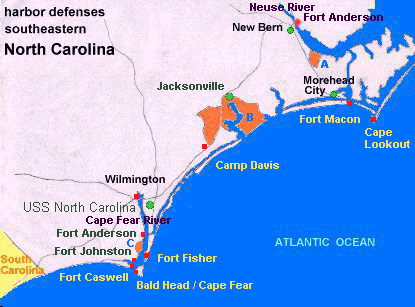
|
| Fort Anderson and Cape Fear River Defense System |
In
1861–1862, Col. William Lamb and Maj. John Hedrick constructed Fort Anderson, one of several Confederate
strongholds that protected Wilmington, a major blockade-running
port. (See The Blockade of Wilmington, North Carolina.) They enlarged Fort St. Philip, an earthen wall with gun emplacements that extended from the ruin to the Cape Fear
River and renamed it Fort Anderson.
Although Lamb had no engineering experience, he applied to the building of fortifications what engineers had learned during
the Crimean War (1854–1856). In July 1862, he assumed command of Fort
Fisher downstream and transformed it into the world’s largest earthwork.
There, as at Fort Anderson,
slaves and Indians moved the dirt and sand “one shovelful at a time.” Adjacent the river were the massive artillery
emplacements that mounted nine seacoast cannons; these cannons were supported by movable field artillery pieces. Large underground
chambers sheltered the garrison and the volatile black powder supply during bombardments.
Key for Map of North Carolina Coastal Defenses:
(A) Cherry Point Marine Corps
Air Station
(B) Camp Lejeune Marine Corps Base &
New River Marine Corps Air Station
(C) US Army Sunny Point Ocean
Terminals
| Fort Anderson Civil War History |
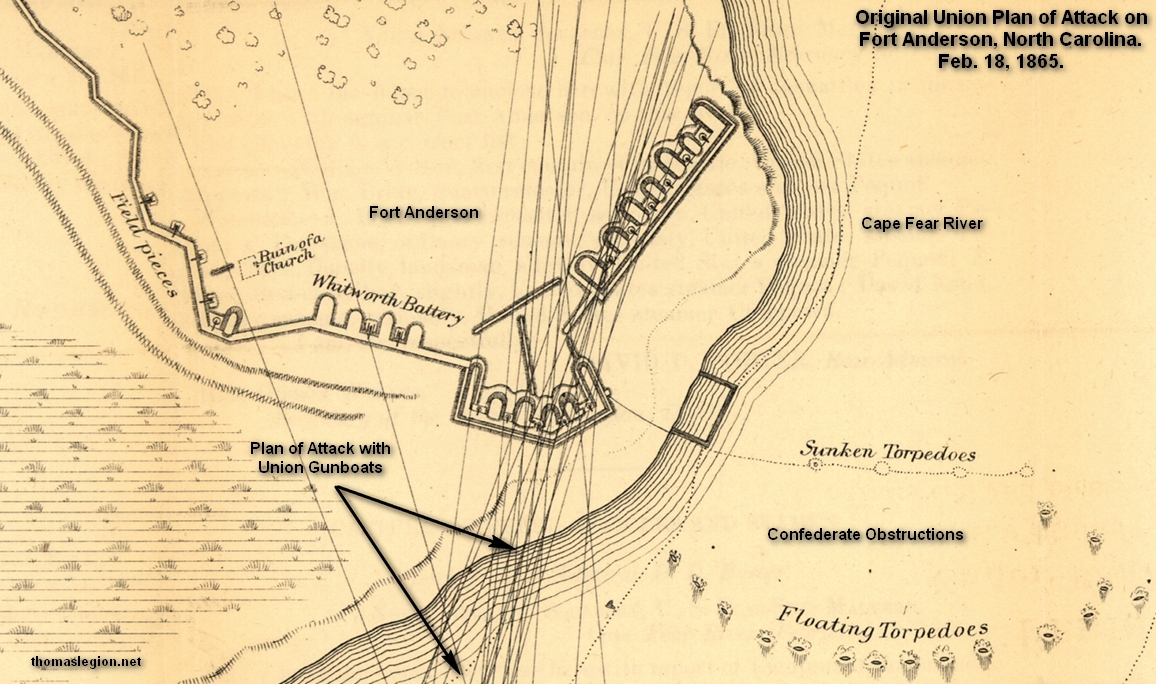
|
| Original Union Plan of Attack on Fort Anderson, dated Feb. 18, 1865. |
On
January 15, 1865, Fort Fisher, the last major fort on the east
coast to remain open during the Union blockade, was taken by a combined Union Army-Navy assault. The forts at the mouth of
the Cape Fear River were then evacuated and destroyed by the Confederates on the night of
January 15/16. For one month the Confederates, commanded by Generals Braxton Bragg and Robert Hoke, managed to contain the
Union forces at their beachhead near Fort Fisher
and in lower Brunswick County at Smithville
(modern Southport). (See Fort Anderson North Carolina.)
| NC and the Civil War |
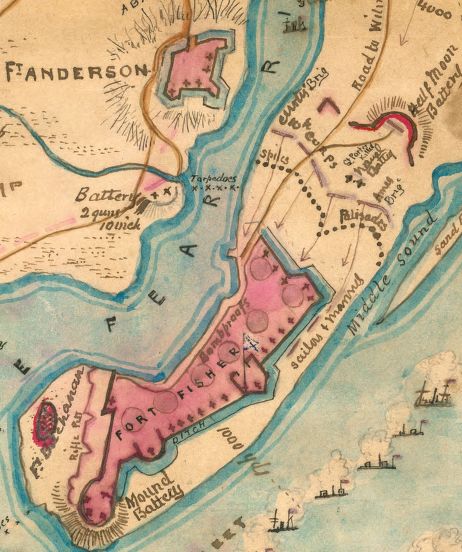
|
| Fort Anderson protecting Wilmington, North Carolina |
| Civil War Battle of Fort Anderson Map |
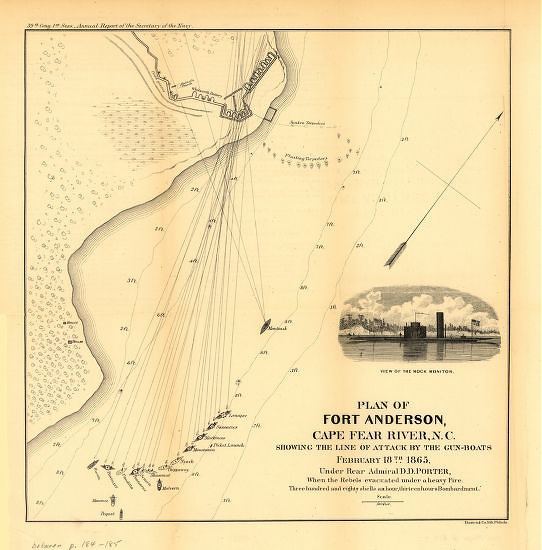
|
| Map of US Navy Vessels in Attack Formation |
(Above) Map of Federal plan of Battle of Fort Anderson, Cape Fear River,
N.C. Map showing the line of attack by the Union gun-boats for February 18th, 1865, under Rear Admiral D. D.
Porter, when the rebels evacuated under a heavy fire. During the thirteen hour bombardment, three hundred and eighty
shells an hour were directed at the fort. (Right) Period map of Fort Fisher and surrounding defenses.
| Guns at Fort Anderson |
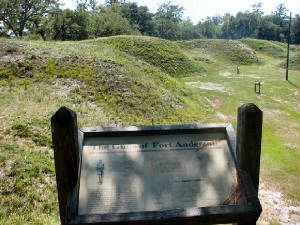
|
| (Click to Enlarge) |
Union General Jacob D. Cox
was directed by Major General John M. Schofield, overall Union commander, to move up the west bank of the Cape Fear River
and advance on Wilmington from the west. The primary obstacle before the town was Fort Anderson. Designed much like Fort Fisher, it boasted
over a mile of earthen fortifications and artillery chambers in addition to batteries that guarded the water approach to the
city. The fort also made use of the natural terrain, using
swampland and ponds as moats and protective defenses along its battlements.
Cox arrived in front of
Fort Anderson
on February 16, 1865. For two days the opposing forces engaged in heavy skirmishing. On the afternoon of February 18, a large
Union force was marched around the head of Orton Pond to flank the Confederate stronghold. After a combined sea bombardment
and land attack, the post was evacuated in the early morning hours of February 19, 1865.
The Confederates then fell back to a prepared position at Town Creek. That position failed to hold and Wilmington fell on February 22 after the extensive naval stores contained in her warehouses
were destroyed by retreating Confederates.
| Present-day Fort Anderson |

|
| Present-day Fort Anderson. Remains of St. Philips Church is on the left. |
References: Chris Fonvielle, Jr.,
The Wilmington
Campaign: Last Rays of Departing Hope (1997); Chris Fonvielle, Jr., Fort Anderson: Battle for Wilmington (1999); Mark A. Moore, The Wilmington
Campaign and the Battles for Fort Fisher (1999); John B. Barrett, The Civil War in North
Carolina (1963); National Park Service; North Carolina Office of Archives and History; Library of
Congress.
Recommended
Reading: Fort Anderson: The Battle For
Wilmington. Description: A detailed but highly readable study of the largest and strongest interior
fortification guarding the Confederacy's last major seaport of Wilmington,
North Carolina. An imposing earthen bastion, Fort Anderson was the scene of a massive two-day
Union naval bombardment and ground assault in late February 1865. Continued below…
The fort's
fall sealed Wilmington's doom. More than a military campaign study, Fort
Anderson: Battle for Wilmington
examines the history of the fort's location from its halcyon days as North Carolina's leading
colonial port of Brunswick
to its beginnings as a Confederate fortification in 1862 and its fall to Union forces three years later. The fort also had
several eerie connections to President Abraham Lincoln's assassination. Today the fort is part of the tranquil Brunswick Town
State Historic Site. Fort Anderson: Battle for Wilmington is liberally illustrated
with maps and illustrations, including many previously unpublished soldiers' images. It also contains an order of battle,
endnotes, bibliography and index.
Recommended
Reading: The Wilmington Campaign: Last Departing Rays of Hope.
Description: While prior books on the battle to capture Wilmington,
North Carolina, have focused solely on the epic struggles for Fort Fisher, in many respects this was just
the beginning of the campaign. In addition to complete coverage (with significant new information) of both battles for Fort Fisher, "The Wilmington Campaign" includes the first
detailed examination of the attack and defense of Fort Anderson. Continued below…
It also
features blow-by-blow accounts of the defense of the Sugar Loaf Line and of the operations of Federal warships on the Cape Fear River. This masterpiece
of military history proves yet again that there is still much to be learned about the American Civil War. "The Wilmington Campaign is a splendid achievement. This gripping chronicle of the five-weeks'
campaign up the Cape Fear River adds a crucial dimension to our understanding of the Confederacy's
collapse." -James McPherson, Pulitzer Prize-winning author of Battle Cry of Freedom
Recommended
Reading: The Wilmington Campaign and the Battle for Fort Fisher, by Mark A. Moore. Description:
Full campaign and battle history of the largest combined operation in U.S.
military history prior to World War II. By late 1864, Wilmington
was the last major Confederate blockade-running seaport open to the outside world. The final battle for the port city's protector--Fort Fisher--culminated
in the largest naval bombardment of the American Civil War, and one of the worst hand-to-hand engagements in four years of
bloody fighting. Continued below…
Copious illustrations,
including 54 original maps drawn by the author. Fresh new analysis on the fall of Fort Fisher, with a fascinating comparison
to Russian defenses at Sebastopol during the Crimean War. “A tour de force. Moore's Fort Fisher-Wilmington Campaign is the best publication of this
character that I have seen in more than 50 years.” -- Edwin C. Bearss, Chief Historian Emeritus, National Park Service
Recommended
Reading: Confederate Goliath: The Battle of Fort
Fisher. From Publishers Weekly: Late in the Civil War, Wilmington, N.C., was the sole remaining seaport supplying Lee's army at Petersburg,
Va., with rations and munitions. In this dramatic account, Gragg describes the
two-phase campaign by which Union forces captured the fort that guarded Wilmington and the subsequent occupation of the city
itself--a victory that virtually doomed the Confederacy. In the initial phase in December 1864, General Ben Butler and Admiral
David Porter directed an unsuccessful amphibious assault against Fort
Fisher that included the war's heaviest artillery bombardment. Continued
below…
The second
try in January '65 brought General Alfred Terry's 9000-man army against 1500 ill-equipped defenders, climaxing in a bloody
hand-to-hand struggle inside the bastion and an overwhelming Union victory. Although historians tend to downplay the event,
it was nevertheless as strategically decisive as the earlier fall of either Vicksburg or Atlanta. Gragg
has done a fine job in restoring this important campaign to public attention. Includes numerous photos.
Recommended
Reading: Iron Afloat:
The Story of the Confederate Armorclads.
Description: William N. Still's book is rightfully referred to as the standard of Confederate Naval history. Accurate and
objective accounts of the major and even minor engagements with Union forces are combined with extensive background information.
This edition has an enlarged section of historical drawings and sketches. Mr. Still explains the political background that
gave rise to the Confederate Ironclad program and his research is impeccable. An exhaustive literature listing rounds out
this excellent book. While strictly scientific, the inclusion of historical eyewitness accounts and the always fluent style
make this book a joy to read. This book is a great starting point.
Recommended
Reading: Seacoast Fortifications of the United States:
An Introductory History. Reader’s
Review: In the thirty years since this book was published, one always hoped another would equal or surpass it. None has, or
perhaps ever will. It is a marvelous history of the Forts along the American Seacoast, both Atlantic and Pacific, and even
the Philippines. …Any Fort enthusiast
must read this book. The author captures so much information, so many views, so much perspective in so few pages, the book
is breathtaking. It is easily the finest book on its chosen subject, which is why it never goes out of print. “If forts
interest you, read it, period.” The photographs from the author's collection, the army's files, the National Archives,
etc., make it an invaluable edition. Continued below…
But the text,
the clear delineation of the periods of fort building since 1794 in the US, and the differentiation of the periods,
are so worth while. Ray manages to be both terse, and pithy. It is a great tribute to any author to say that. “This
is a MUST read for anyone interested in the subject, even one only interested in their own local Fort, and how it relates
to the defense plans of the United States when it was built.” “[T]here is NO better book to read on the subject.”
|

